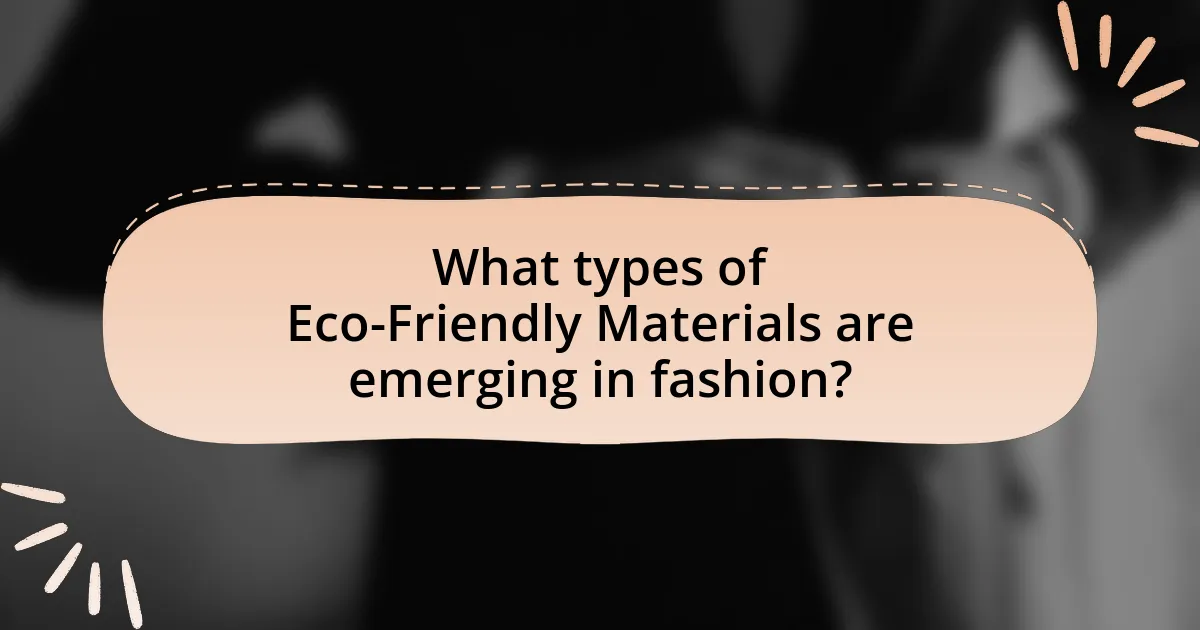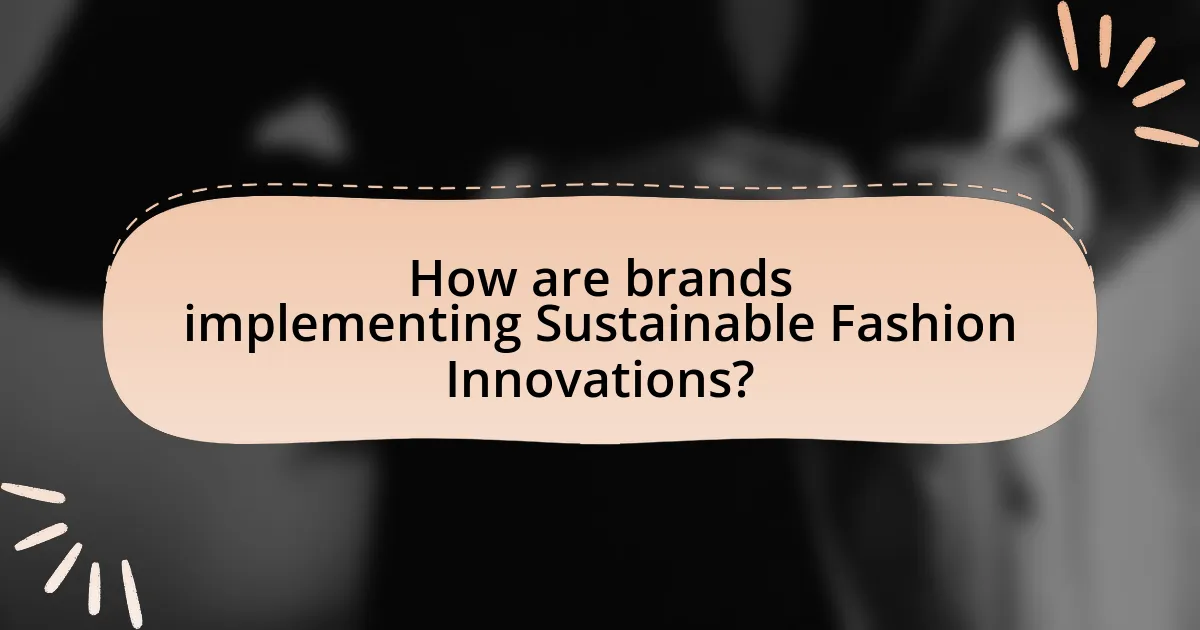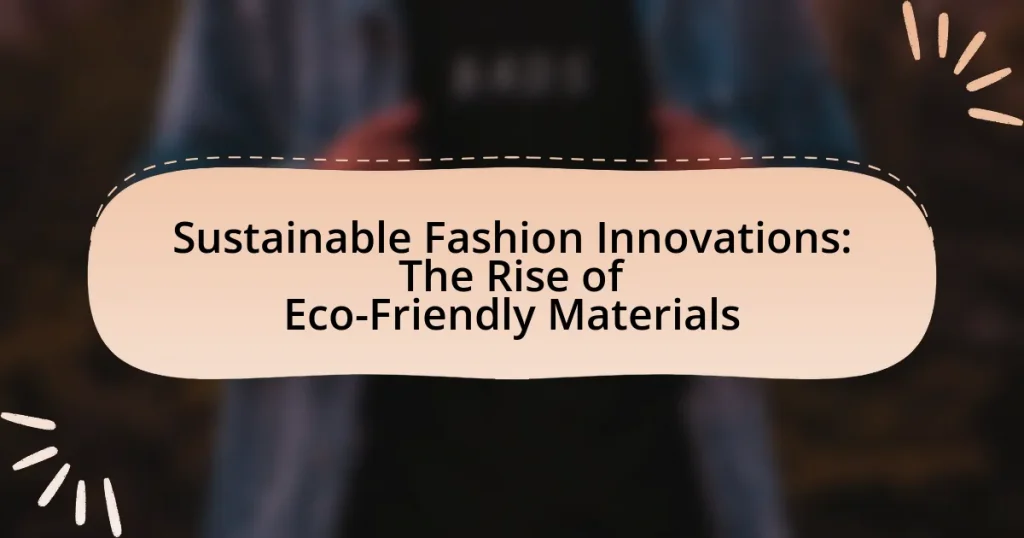Sustainable fashion innovations focus on advancements in the fashion industry that prioritize environmental and social responsibility through the use of eco-friendly materials and practices. Key innovations include organic cotton, recycled polyester, and biodegradable fabrics, which significantly reduce resource consumption and carbon emissions. The rise of these innovations is driven by increasing consumer awareness, regulatory pressures, and technological advancements, leading to a shift towards circular fashion and ethical labor practices. The article explores the impact of sustainable materials on the industry, the challenges brands face in adopting these practices, and practical steps consumers can take to support sustainable fashion.

What are Sustainable Fashion Innovations?
Sustainable fashion innovations are advancements in the fashion industry that prioritize environmental and social responsibility. These innovations include the development of eco-friendly materials, such as organic cotton, recycled polyester, and biodegradable fabrics, which reduce the ecological footprint of clothing production. For instance, the use of recycled materials can significantly lower carbon emissions; a study by the Ellen MacArthur Foundation found that using recycled polyester can reduce emissions by up to 75% compared to virgin polyester. Additionally, sustainable fashion innovations encompass practices like zero-waste design, circular fashion, and ethical labor practices, all aimed at creating a more sustainable and equitable fashion ecosystem.
How do Sustainable Fashion Innovations impact the industry?
Sustainable fashion innovations significantly impact the industry by promoting eco-friendly materials and practices that reduce environmental harm. These innovations lead to a decrease in resource consumption, with studies indicating that using organic cotton can reduce water usage by up to 91% compared to conventional cotton. Additionally, the adoption of recycled materials, such as polyester made from plastic bottles, diverts waste from landfills and decreases reliance on virgin resources. This shift not only enhances brand reputation among environmentally conscious consumers but also drives competitive advantage, as companies that embrace sustainability often see increased sales and customer loyalty.
What are the key drivers behind the rise of Sustainable Fashion Innovations?
The key drivers behind the rise of Sustainable Fashion Innovations include increasing consumer awareness, regulatory pressures, and advancements in technology. Consumer awareness has surged due to the growing concern over environmental issues, with studies indicating that 66% of global consumers are willing to pay more for sustainable brands. Regulatory pressures from governments and organizations are pushing brands to adopt sustainable practices, as seen in the European Union’s Green Deal aimed at making the fashion industry more sustainable. Additionally, technological advancements, such as the development of biodegradable materials and recycling processes, are enabling brands to innovate sustainably, exemplified by companies like Stella McCartney utilizing eco-friendly fabrics.
How do consumer preferences influence Sustainable Fashion Innovations?
Consumer preferences significantly influence sustainable fashion innovations by driving demand for eco-friendly materials and ethical production practices. As consumers increasingly prioritize sustainability, brands respond by developing innovative materials such as organic cotton, recycled polyester, and biodegradable fabrics. A 2021 survey by McKinsey & Company found that 67% of consumers consider sustainability when making a purchase, prompting fashion companies to invest in sustainable technologies and practices to meet this demand. This shift not only enhances brand loyalty but also encourages the entire industry to adopt more sustainable practices, ultimately leading to a broader transformation in fashion towards eco-friendliness.
Why is the focus on Eco-Friendly Materials important?
The focus on eco-friendly materials is important because they significantly reduce environmental impact and promote sustainability in fashion. Eco-friendly materials, such as organic cotton and recycled polyester, minimize resource consumption and waste generation during production. For instance, using organic cotton can reduce water usage by up to 91% compared to conventional cotton farming, as reported by the Textile Exchange. Additionally, eco-friendly materials often have a lower carbon footprint, contributing to the fight against climate change. By prioritizing these materials, the fashion industry can foster a more sustainable future while meeting consumer demand for environmentally responsible products.
What environmental issues are addressed by Eco-Friendly Materials?
Eco-friendly materials address several environmental issues, including resource depletion, pollution, and waste management. These materials are often derived from renewable resources, which helps reduce the strain on finite natural resources. For instance, organic cotton and bamboo require less water and pesticides compared to conventional materials, thereby minimizing environmental degradation. Additionally, eco-friendly materials typically involve less harmful manufacturing processes, which reduces air and water pollution. According to a study published in the Journal of Cleaner Production, using recycled materials can significantly lower carbon emissions and energy consumption in the fashion industry. Furthermore, eco-friendly materials contribute to waste reduction by being biodegradable or recyclable, thus mitigating landfill overflow and promoting a circular economy.
How do Eco-Friendly Materials contribute to sustainability in fashion?
Eco-friendly materials contribute to sustainability in fashion by reducing environmental impact through the use of renewable resources and minimizing waste. These materials, such as organic cotton, hemp, and recycled polyester, require less water and energy to produce compared to conventional fabrics. For instance, organic cotton uses 91% less water than traditional cotton farming, significantly lowering water consumption in the textile industry. Additionally, eco-friendly materials often involve processes that emit fewer greenhouse gases, further decreasing the carbon footprint associated with fashion production. By prioritizing these sustainable materials, the fashion industry can move towards a circular economy, where products are designed for longevity and recyclability, thus promoting a more sustainable future.

What types of Eco-Friendly Materials are emerging in fashion?
Emerging eco-friendly materials in fashion include organic cotton, Tencel, recycled polyester, and hemp. Organic cotton is cultivated without synthetic pesticides, making it a sustainable alternative to conventional cotton. Tencel, derived from sustainably sourced wood pulp, is biodegradable and produced in a closed-loop process that minimizes waste. Recycled polyester, made from post-consumer plastic bottles, reduces reliance on virgin materials and diverts waste from landfills. Hemp is a fast-growing plant that requires minimal water and pesticides, making it an environmentally friendly textile choice. These materials are gaining traction as brands seek to reduce their environmental impact and promote sustainability in the fashion industry.
How are natural fibers being utilized in sustainable fashion?
Natural fibers are utilized in sustainable fashion by serving as eco-friendly alternatives to synthetic materials, significantly reducing environmental impact. These fibers, such as organic cotton, hemp, and linen, are biodegradable, require less water and pesticides compared to conventional textiles, and contribute to lower carbon emissions during production. For instance, organic cotton uses 91% less water than conventional cotton, making it a more sustainable choice. Additionally, brands like Patagonia and Eileen Fisher incorporate natural fibers into their collections, promoting circular fashion practices by encouraging recycling and upcycling of these materials. This shift towards natural fibers not only supports sustainable agriculture but also aligns with consumer demand for environmentally responsible products.
What are the benefits of using organic cotton and hemp?
Organic cotton and hemp offer significant benefits for sustainable fashion, primarily due to their environmentally friendly cultivation methods and natural properties. Organic cotton is grown without synthetic pesticides or fertilizers, which reduces soil and water pollution, while hemp requires less water and no pesticides, making it a highly sustainable crop. Additionally, both materials are biodegradable, contributing to reduced waste in landfills. Studies indicate that organic cotton farming can use up to 91% less water compared to conventional cotton farming, and hemp can produce more fiber per acre than cotton, making it a more efficient resource. These factors collectively enhance the sustainability of fashion products made from organic cotton and hemp.
How do innovations in bamboo and Tencel enhance sustainability?
Innovations in bamboo and Tencel enhance sustainability by utilizing renewable resources and reducing environmental impact. Bamboo grows rapidly, requiring minimal water and no pesticides, making it a highly sustainable raw material. Tencel, derived from sustainably sourced wood pulp, is produced in a closed-loop process that recycles water and solvents, minimizing waste. Both materials are biodegradable, contributing to a circular economy. Studies indicate that bamboo can sequester carbon dioxide effectively, while Tencel’s production process results in lower greenhouse gas emissions compared to conventional fibers.
What role do recycled materials play in sustainable fashion?
Recycled materials are essential in sustainable fashion as they significantly reduce waste and resource consumption. By utilizing materials that have already been processed, the fashion industry can minimize the demand for virgin resources, which often involve environmentally harmful extraction and production processes. For instance, using recycled polyester can save up to 60% of energy compared to producing new polyester from petroleum. This practice not only conserves natural resources but also decreases greenhouse gas emissions associated with manufacturing. Furthermore, the incorporation of recycled materials into fashion products helps divert waste from landfills, contributing to a circular economy where materials are reused and repurposed, thus promoting sustainability in the industry.
How is recycled polyester transforming the fashion industry?
Recycled polyester is transforming the fashion industry by significantly reducing waste and resource consumption. This material, derived from post-consumer plastic bottles and other recycled plastics, helps to divert millions of tons of plastic from landfills and oceans each year. For instance, the Global Fashion Agenda reported that using recycled polyester can reduce greenhouse gas emissions by up to 75% compared to virgin polyester production. Additionally, brands like Patagonia and Adidas have successfully integrated recycled polyester into their product lines, demonstrating its viability and appeal to environmentally conscious consumers. This shift not only promotes sustainability but also encourages innovation in textile production, leading to a more circular economy within the fashion sector.
What are the challenges associated with using recycled materials?
The challenges associated with using recycled materials include quality inconsistency, limited availability, and higher processing costs. Quality inconsistency arises because recycled materials can vary significantly in composition and performance, making it difficult to ensure uniformity in the final product. Limited availability is a challenge as the supply of high-quality recycled materials may not meet the demand, particularly in industries like fashion where specific materials are required. Higher processing costs occur because recycling processes can be more complex and energy-intensive compared to using virgin materials, which can deter manufacturers from adopting recycled options. These challenges hinder the widespread adoption of recycled materials in sustainable fashion innovations.

How are brands implementing Sustainable Fashion Innovations?
Brands are implementing sustainable fashion innovations by integrating eco-friendly materials into their production processes. For instance, companies like Stella McCartney utilize organic cotton and recycled polyester to reduce environmental impact. Additionally, brands such as Patagonia have adopted a circular economy model, encouraging customers to repair and recycle their garments, which minimizes waste. Research indicates that the global sustainable fashion market is projected to reach $8.25 billion by 2023, highlighting the increasing commitment of brands to sustainability.
What strategies are brands adopting to incorporate Eco-Friendly Materials?
Brands are adopting several strategies to incorporate eco-friendly materials, including sourcing sustainable fibers, utilizing recycled materials, and implementing innovative production techniques. For instance, many brands are now using organic cotton, Tencel, and hemp, which require fewer resources and chemicals compared to conventional materials. Additionally, the use of recycled polyester, derived from plastic bottles, has gained traction, with companies like Patagonia leading the way by incorporating recycled content into their products. Furthermore, brands are investing in technologies such as 3D knitting and digital printing, which minimize waste and reduce the environmental impact of production processes. These strategies not only enhance sustainability but also align with consumer demand for environmentally responsible products.
How do collaborations with sustainable suppliers enhance brand offerings?
Collaborations with sustainable suppliers enhance brand offerings by integrating eco-friendly materials and practices into product lines. This integration not only improves the environmental impact of the products but also aligns the brand with consumer values that prioritize sustainability. For instance, brands that partner with suppliers using organic cotton or recycled materials can market their products as environmentally responsible, appealing to a growing demographic of eco-conscious consumers. Research indicates that 66% of global consumers are willing to pay more for sustainable brands, demonstrating the market demand for such collaborations.
What are the marketing approaches for promoting sustainable fashion?
Marketing approaches for promoting sustainable fashion include storytelling, influencer partnerships, and transparency in sourcing. Storytelling engages consumers by highlighting the environmental and social impact of sustainable practices, making the brand’s mission relatable. Influencer partnerships leverage the reach of eco-conscious influencers to authentically promote sustainable products, increasing brand visibility among target audiences. Transparency in sourcing builds trust by providing consumers with information about materials, production processes, and labor practices, which is crucial for informed purchasing decisions. According to a 2021 survey by McKinsey, 67% of consumers consider sustainability when making fashion purchases, underscoring the effectiveness of these marketing strategies.
What challenges do brands face in adopting sustainable practices?
Brands face significant challenges in adopting sustainable practices, primarily due to high costs, supply chain complexities, and consumer demand for immediate results. The transition to eco-friendly materials often requires substantial investment in new technologies and processes, which can strain financial resources. Additionally, sourcing sustainable materials can complicate supply chains, as these materials may not be readily available or may require new partnerships with suppliers. Furthermore, consumers often expect lower prices and quick delivery, which can conflict with the longer timelines and higher costs associated with sustainable practices. According to a 2021 McKinsey report, 66% of fashion executives cited cost as a major barrier to sustainability, highlighting the financial pressures brands face in this transition.
How do cost implications affect the adoption of Eco-Friendly Materials?
Cost implications significantly hinder the adoption of eco-friendly materials in sustainable fashion. The higher initial costs associated with sourcing and producing eco-friendly materials often deter manufacturers and consumers, as they may prioritize lower-priced alternatives. For instance, a study by the Ellen MacArthur Foundation indicates that sustainable materials can cost up to 30% more than conventional options, impacting profit margins and pricing strategies. Consequently, brands may hesitate to invest in eco-friendly materials, fearing reduced competitiveness in a price-sensitive market. This financial barrier ultimately slows the transition towards more sustainable practices in the fashion industry.
What are the barriers to consumer acceptance of sustainable fashion?
The barriers to consumer acceptance of sustainable fashion include higher costs, limited availability, and lack of awareness. Higher costs deter consumers who prioritize affordability over sustainability, as sustainable fashion often comes with a premium price tag due to ethical production practices. Limited availability restricts access to sustainable options, making it difficult for consumers to find eco-friendly products in mainstream retail settings. Additionally, a lack of awareness about the environmental impact of fast fashion and the benefits of sustainable alternatives contributes to consumer reluctance. Research indicates that 66% of global consumers are willing to pay more for sustainable brands, yet many remain uninformed about their options, highlighting the need for increased education and accessibility in the sustainable fashion market.
What practical steps can consumers take to support sustainable fashion?
Consumers can support sustainable fashion by choosing to buy from brands that prioritize eco-friendly materials and ethical production practices. This includes researching companies that use organic, recycled, or biodegradable fabrics, as well as those that ensure fair labor conditions. According to a 2021 report by the Global Fashion Agenda, sustainable brands are gaining traction, with 66% of consumers willing to pay more for sustainable products. Additionally, consumers can reduce their fashion footprint by buying second-hand clothing, participating in clothing swaps, and properly recycling garments at the end of their life cycle. These actions collectively contribute to a decrease in waste and promote a circular economy in the fashion industry.
How can consumers identify truly sustainable brands?
Consumers can identify truly sustainable brands by examining their transparency, certifications, and practices. Brands that openly share their supply chain information, use third-party certifications like Fair Trade or Global Organic Textile Standard, and demonstrate environmentally friendly practices, such as using recycled materials or reducing carbon emissions, are more likely to be genuinely sustainable. For instance, a 2021 report by the Fashion Transparency Index found that only 40% of brands disclose their supply chain information, indicating that transparency is a key indicator of sustainability.
What are the best practices for maintaining Eco-Friendly fashion items?
To maintain eco-friendly fashion items effectively, it is essential to follow specific best practices. First, washing these items in cold water reduces energy consumption and minimizes fabric damage. Additionally, air drying instead of using a dryer conserves energy and prolongs the lifespan of the garments. Regularly cleaning items with natural detergents prevents harmful chemicals from entering the environment. Furthermore, storing eco-friendly fashion items in a cool, dry place protects them from mold and degradation. Lastly, repairing rather than discarding damaged items promotes sustainability and reduces waste. These practices collectively support the longevity and environmental integrity of eco-friendly fashion.




